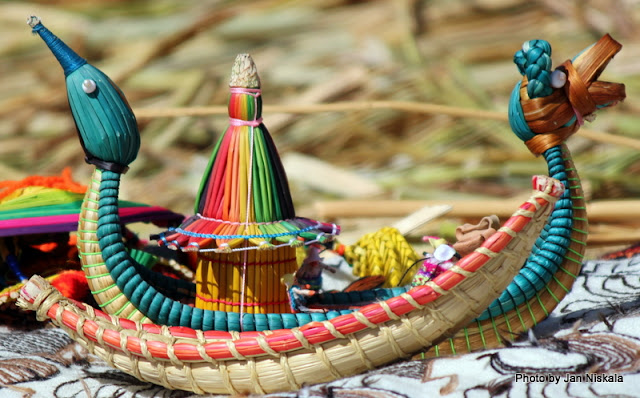Uros Islands on Lake
Titicaca
Lake Titicaca shimmers
above South America at 12,507 feet above
sea level, the highest navigable lake in the world. Lake
Titicaca boarders Peru and Bolivia. The Uros are a people who live on
forty-two self-fashioned floating islands in Lake Titicaca, Puno, Peru.
The Uros descend from a
millennial town that, according to legends, are "pukinas" who speak
Uro or Pukina and that believe they are the owners of the lake and water. Uros
used to say that they have black blood because they did not feel the cold. Also
they call themselves "Lupihaques" (Sons of The Sun). Nowadays, Uros
do not speak the Uro language, nor practice their old beliefs, but keep some
of the old customs.

The purpose of the island settlements was originally defensive, and if a
threat arose they could be moved. The largest island retains a watchtower
almost entirely constructed of reeds. The
larger islands house about ten families, while smaller ones, only about thirty
meters wide, house only two or three.
 |
| The photos above and below show a small work boat travelling to one of the islands loaded with reeds that have been cut and will be used to fortify the island. |
The islets are made of totora reeds, which grow in the lake. The dense
roots that the plants develop and interweave form a natural layer called Khili
(about one to two meters thick) that support the islands.
They are anchored
with ropes attached to sticks driven into the bottom of the lake. The reeds at
the bottoms of the islands rot away fairly quickly, so new reeds are added to
the top constantly, about every three months; this is what makes it exciting
for tourists when walking on the island. This is especially important in the rainy
season when the reeds rot much faster. The islands last about thirty years. [Wikipedia]
Each step on an island sinks about 2-4" depending on the density of
the ground underfoot. As the reeds dry, they break up more and more as they are
walked upon. As the reed breaks up and moisture gets to it, it rots, and a new
layer has to be added to it. Below is a demonstration of how they build their islands.
It is a lot of work to maintain the islands.
Because the people living there are so infiltrated with tourists now, they have
less time to maintain everything, so they have to work even harder in order to
keep up with the tourists and with the maintenance of their island. Tourism provides financial opportunities for
the natives, while simultaneously challenging their traditional lifestyle. [Wikipedia]
The natives spend a good deal of time creating beautiful crafts including
blankets, wall hangings, small models of the reed homes and boats, pottery, and
wind chimes.
Food is cooked with fires placed on piles of stones. To relieve themselves,
tiny 'outhouse' islands are near the main islands. The ground root absorbs the
waste.
Much of the Uros' diet and medicine also revolve around the same totora
reeds used to construct the islands. When a reed is pulled, the white bottom is
often eaten for iodine. This prevents goitres. This white part of the reed is
called the chullo (Aymara). Like the Andean
people of Peru who rely on the Coca Leaf for relief from a harsh climate and
hunger, the Uros rely on the Totora reeds in the same way. When in pain, the
reed is wrapped around the place in pain to absorb it. Also if it is hot
outside, they roll the white part of the reed in their hands and split it open,
placing the reed on their forehead. In this stage, it is very cool to the
touch. The white part of the reed is also used to help ease alcohol-related
hangovers. It is a primary source of food. They also make a reed flower tea.
Local residents fish ispi, carachi and catfish. Trout was introduced to the
lake from Canada in 1940, and kingfish was introduced from Argentina. Uros also
hunt birds such as seagulls, ducks and flamingos, and graze their cattle on the
islets. They barter totora reeds on the mainland in Puno
to get products they need, such as quinoa and other foods.
The Uros do not reject modern technology: some boats have motors, some
houses have solar panels to run appliances such as televisions, and the main
island is home to an Uros-run FM radio station, which plays music for several
hours a day.
 |
| We were surprised when we saw the Solar Panels! |
Early schooling is done on several islands, including a traditional school
and a school run by a Christian church. Older children and university students
attend school on the mainland, often in nearby Puno. [Wikipedia]
We truly enjoyed visiting
the Islands. We had fun with the
residents, rode one of their amazing reed boats, saw a demonstration on how
their island is built and even visited an island that is actually a ‘Bed and
Breakfast’! It would have been fun to
spend a night there!
 |
| A new Island being built |
 |
| Farewell to Uros Islands |
Hope you enjoyed our visit
to Uros Islands on Lake Titicaca. There
is still a bit more to come from our Peru visit so keep an eye out!
More soon! ☺
Jan 🌷🌷🐾🐾 








































No comments:
Post a Comment